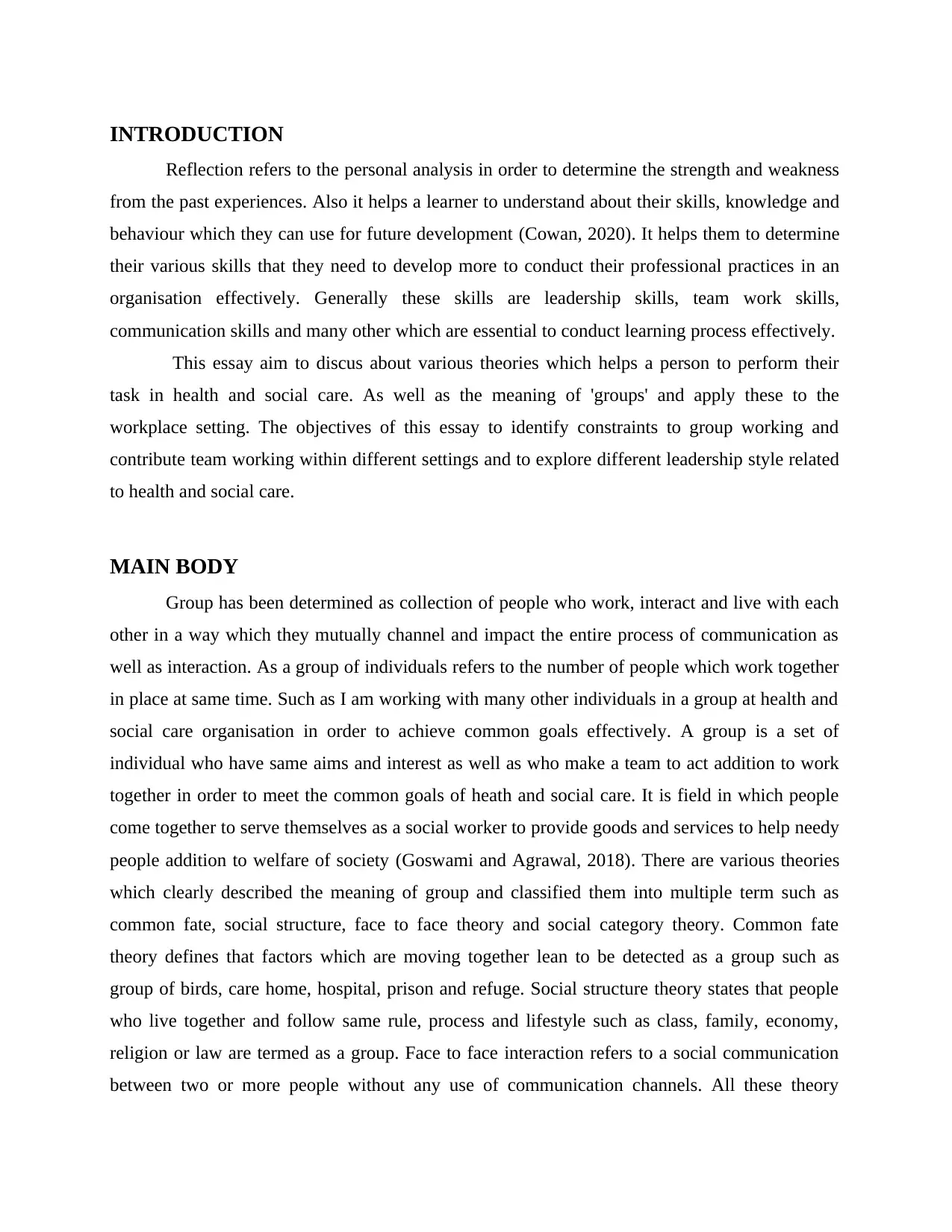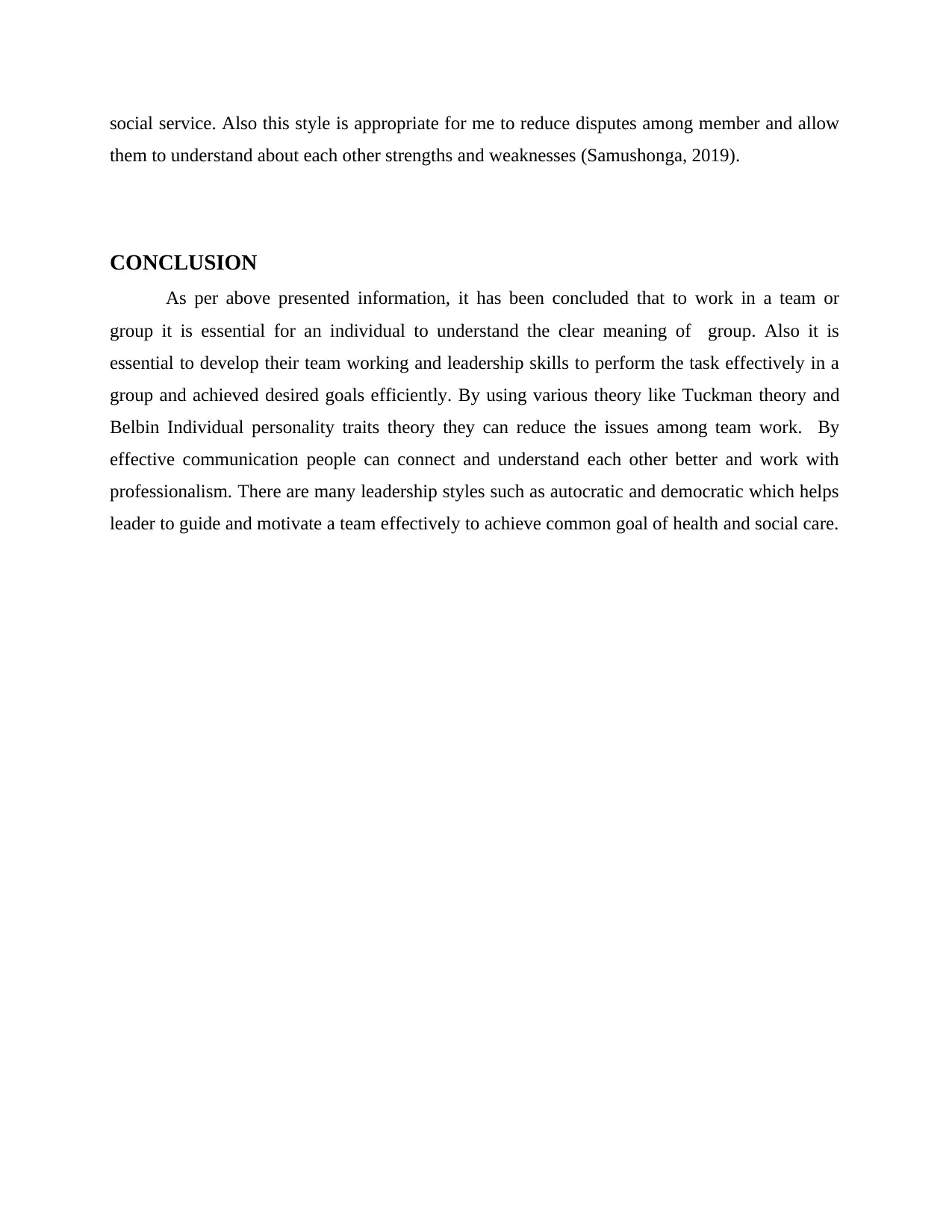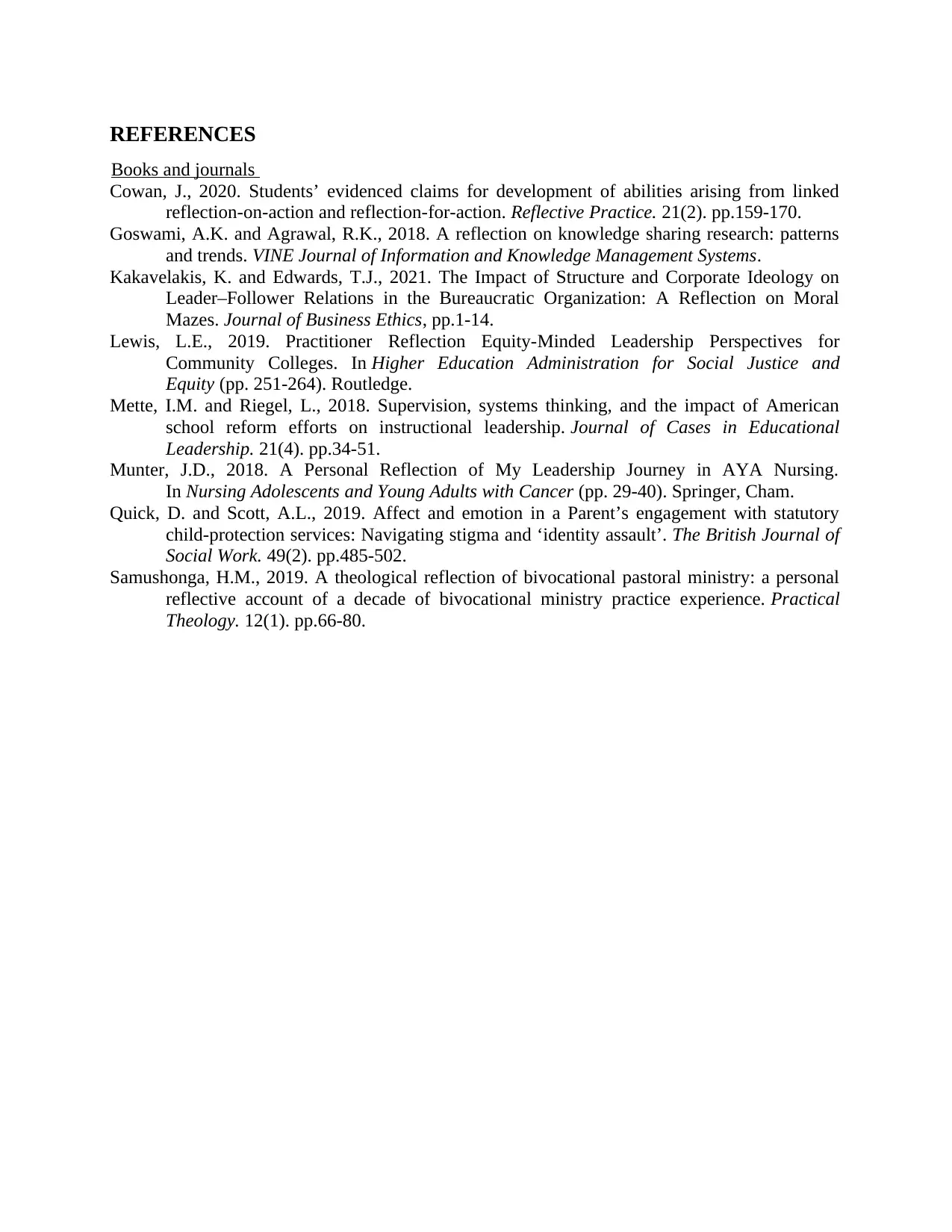Examining Group Theories and Leadership in Health and Social Care Work
VerifiedAdded on 2023/06/10
|7
|1905
|134
Essay
AI Summary
This essay provides a reflective account on group theories and leadership styles within the context of health and social care. It discusses the meaning of 'groups' and applies various theories, including common fate, social structure, face-to-face interaction, and social category theory, to workplace settings. The essay identifies constraints to group working, such as conflicts arising from differing personalities and backgrounds, and suggests using Tuckman's theory of team effectiveness and Belbin's individual personality traits theory to mitigate these issues. Different leadership styles, including autocratic and democratic approaches, are explored for their effectiveness in leading teams towards common goals. The reflection emphasizes the importance of effective communication, understanding team roles, and developing leadership skills to foster unity and professionalism within health and social care organizations.

Reflection Account
Paraphrase This Document
Need a fresh take? Get an instant paraphrase of this document with our AI Paraphraser

Contents
INTRODUCTION...........................................................................................................................1
MAIN BODY ..................................................................................................................................1
CONCLUSION ...............................................................................................................................1
REFERENCES................................................................................................................................3
INTRODUCTION...........................................................................................................................1
MAIN BODY ..................................................................................................................................1
CONCLUSION ...............................................................................................................................1
REFERENCES................................................................................................................................3

INTRODUCTION
Reflection refers to the personal analysis in order to determine the strength and weakness
from the past experiences. Also it helps a learner to understand about their skills, knowledge and
behaviour which they can use for future development (Cowan, 2020). It helps them to determine
their various skills that they need to develop more to conduct their professional practices in an
organisation effectively. Generally these skills are leadership skills, team work skills,
communication skills and many other which are essential to conduct learning process effectively.
This essay aim to discus about various theories which helps a person to perform their
task in health and social care. As well as the meaning of 'groups' and apply these to the
workplace setting. The objectives of this essay to identify constraints to group working and
contribute team working within different settings and to explore different leadership style related
to health and social care.
MAIN BODY
Group has been determined as collection of people who work, interact and live with each
other in a way which they mutually channel and impact the entire process of communication as
well as interaction. As a group of individuals refers to the number of people which work together
in place at same time. Such as I am working with many other individuals in a group at health and
social care organisation in order to achieve common goals effectively. A group is a set of
individual who have same aims and interest as well as who make a team to act addition to work
together in order to meet the common goals of heath and social care. It is field in which people
come together to serve themselves as a social worker to provide goods and services to help needy
people addition to welfare of society (Goswami and Agrawal, 2018). There are various theories
which clearly described the meaning of group and classified them into multiple term such as
common fate, social structure, face to face theory and social category theory. Common fate
theory defines that factors which are moving together lean to be detected as a group such as
group of birds, care home, hospital, prison and refuge. Social structure theory states that people
who live together and follow same rule, process and lifestyle such as class, family, economy,
religion or law are termed as a group. Face to face interaction refers to a social communication
between two or more people without any use of communication channels. All these theory
Reflection refers to the personal analysis in order to determine the strength and weakness
from the past experiences. Also it helps a learner to understand about their skills, knowledge and
behaviour which they can use for future development (Cowan, 2020). It helps them to determine
their various skills that they need to develop more to conduct their professional practices in an
organisation effectively. Generally these skills are leadership skills, team work skills,
communication skills and many other which are essential to conduct learning process effectively.
This essay aim to discus about various theories which helps a person to perform their
task in health and social care. As well as the meaning of 'groups' and apply these to the
workplace setting. The objectives of this essay to identify constraints to group working and
contribute team working within different settings and to explore different leadership style related
to health and social care.
MAIN BODY
Group has been determined as collection of people who work, interact and live with each
other in a way which they mutually channel and impact the entire process of communication as
well as interaction. As a group of individuals refers to the number of people which work together
in place at same time. Such as I am working with many other individuals in a group at health and
social care organisation in order to achieve common goals effectively. A group is a set of
individual who have same aims and interest as well as who make a team to act addition to work
together in order to meet the common goals of heath and social care. It is field in which people
come together to serve themselves as a social worker to provide goods and services to help needy
people addition to welfare of society (Goswami and Agrawal, 2018). There are various theories
which clearly described the meaning of group and classified them into multiple term such as
common fate, social structure, face to face theory and social category theory. Common fate
theory defines that factors which are moving together lean to be detected as a group such as
group of birds, care home, hospital, prison and refuge. Social structure theory states that people
who live together and follow same rule, process and lifestyle such as class, family, economy,
religion or law are termed as a group. Face to face interaction refers to a social communication
between two or more people without any use of communication channels. All these theory
⊘ This is a preview!⊘
Do you want full access?
Subscribe today to unlock all pages.

Trusted by 1+ million students worldwide

defines group in different prospectus and manner but in Health and social care organisation these
theory is not proper applied to define the clear meaning of group. As there is another theory
which is social category theory is the perfect example which define the accurate meaning of
group. This theory defines that group is a collection of people which have similar traits and
characteristics as well as they work together to achieve their common goals. As I am working in
a group at health care organisation with other people which belong to my locality in order to
provide social services to the community (Kakavelakis and Edwards, 2021). All theories is
applied at this workplace to determine and understand proper meaning of groups. As groups are
formed on the basis of same traits, characteristics and skills which works together to meet their
common goals. In Health and Social care there are various groups such as NGO, hospital, charity
trust and many other which works for betterment of society.
At my workplace there are various constraints and challenges among team working such
as conflicts, misunderstanding, disputes, difference among works which impacted the
environment and working at Health and Social care organisation. This constraints is arise because
of different personality traits, mindsets, view point, culture and background. In order to reduce
these issues and mitigate the constraints among team working I can use Tuckman theory and
Belbin Individual personality traits theory (Lewis, 2019).
Tukman is the team effectiveness theory which helps me as a member of Health and
Social care workplace to increase effectiveness among group and lead them in same direction to
reduce differences. There are five stage of this theory such as forming, storming, norming,
performing and adjourning. In the first step which is forming I can classified people as per their
skills, interest and traits and make effective team so they can relate and connect better with each
other as well as understand each other point of view in order to achieve objectives of social
service, then in next step of storming I can assign duty to each members of group as per their
skills so they get clear information about their role in a group to complete the task effectively. In
this stage people know about each other and under their way of working so in the next stage
which is norming people are familiar to each other and task addition to make plan for common
efforts in order to perform task and meet the target before deadline efficiently (Mette and Riegel,
2018). At the stage of performing people start I start working with team on plan at Health and
Social care workplace with unity which helps us to complete task of social care effectively. Also
theory is not proper applied to define the clear meaning of group. As there is another theory
which is social category theory is the perfect example which define the accurate meaning of
group. This theory defines that group is a collection of people which have similar traits and
characteristics as well as they work together to achieve their common goals. As I am working in
a group at health care organisation with other people which belong to my locality in order to
provide social services to the community (Kakavelakis and Edwards, 2021). All theories is
applied at this workplace to determine and understand proper meaning of groups. As groups are
formed on the basis of same traits, characteristics and skills which works together to meet their
common goals. In Health and Social care there are various groups such as NGO, hospital, charity
trust and many other which works for betterment of society.
At my workplace there are various constraints and challenges among team working such
as conflicts, misunderstanding, disputes, difference among works which impacted the
environment and working at Health and Social care organisation. This constraints is arise because
of different personality traits, mindsets, view point, culture and background. In order to reduce
these issues and mitigate the constraints among team working I can use Tuckman theory and
Belbin Individual personality traits theory (Lewis, 2019).
Tukman is the team effectiveness theory which helps me as a member of Health and
Social care workplace to increase effectiveness among group and lead them in same direction to
reduce differences. There are five stage of this theory such as forming, storming, norming,
performing and adjourning. In the first step which is forming I can classified people as per their
skills, interest and traits and make effective team so they can relate and connect better with each
other as well as understand each other point of view in order to achieve objectives of social
service, then in next step of storming I can assign duty to each members of group as per their
skills so they get clear information about their role in a group to complete the task effectively. In
this stage people know about each other and under their way of working so in the next stage
which is norming people are familiar to each other and task addition to make plan for common
efforts in order to perform task and meet the target before deadline efficiently (Mette and Riegel,
2018). At the stage of performing people start I start working with team on plan at Health and
Social care workplace with unity which helps us to complete task of social care effectively. Also
Paraphrase This Document
Need a fresh take? Get an instant paraphrase of this document with our AI Paraphraser

at the last stage, adjourning we can achieve our goal and reduce the conflicts and constraints of
team work which leads to strengthen our connection for future task.
Belbin Individual personality traits theory has 9 team role such as the monitor
evaluator, the specialist, the plant, the shaper, the implementer, the completer, the coordinator
and team worker. Which helps me to determine my role in a team or a group so I can develop my
strengths as well as manage my weaknesses as group member in order to improve my team
working skills to contribute in the achievement of common goals. At Health and Social care
workplace, I am working with many people in Group which perform different role as per their
interest and speciality to complete the task in efficient manner. This theory helps me to
understand each other role to bring harmony in team working (Munter, 2018).
This theory helps us to bring more professionalism among our team working in which
team members work with more responsibility. Such as formal group is more associated with
professional level of working as well as make environment of Health and Social care workplace
is employee task oriented which helps them to know about their duty and complete task on time.
Proper role, duty, responsibility, task and authority is the element to bring formal group as
division of work helps them to complete the task effectively and efficiency. Effective
communication is the key to bring unity among team work as if I can communicate properly and
share information, problems in right manner with team member then I can reduce issues and
challenges (Quick and Scott, 2019).
Leadership styles includes various styles such as autocratic, democratic and transformable
leadership style. These leadership styles I can use in the Health and Social care workplace to lead
people in a team in same direction. As in autocratic leadership style I can make proper plan or
strategy for a task and instruct team member to perform their task as per plan to complete it on
time without allowing them in planning. This style helps me to reduce conflict among team
which is created for division of work. This style helps me as a leader to make a formal team
which works with professionalism and give their full efforts for the welfare of society. Where as,
in In democratic leadership style, as a leader at Health and Social care workplace I can allow
team member to participate in decision making, give their suggestion which helps me to
understand their mindset or ability to assign task duty to them. This leadership style helps to
motivate them and connect with them better so they give their full efforts to achieve goals of
team work which leads to strengthen our connection for future task.
Belbin Individual personality traits theory has 9 team role such as the monitor
evaluator, the specialist, the plant, the shaper, the implementer, the completer, the coordinator
and team worker. Which helps me to determine my role in a team or a group so I can develop my
strengths as well as manage my weaknesses as group member in order to improve my team
working skills to contribute in the achievement of common goals. At Health and Social care
workplace, I am working with many people in Group which perform different role as per their
interest and speciality to complete the task in efficient manner. This theory helps me to
understand each other role to bring harmony in team working (Munter, 2018).
This theory helps us to bring more professionalism among our team working in which
team members work with more responsibility. Such as formal group is more associated with
professional level of working as well as make environment of Health and Social care workplace
is employee task oriented which helps them to know about their duty and complete task on time.
Proper role, duty, responsibility, task and authority is the element to bring formal group as
division of work helps them to complete the task effectively and efficiency. Effective
communication is the key to bring unity among team work as if I can communicate properly and
share information, problems in right manner with team member then I can reduce issues and
challenges (Quick and Scott, 2019).
Leadership styles includes various styles such as autocratic, democratic and transformable
leadership style. These leadership styles I can use in the Health and Social care workplace to lead
people in a team in same direction. As in autocratic leadership style I can make proper plan or
strategy for a task and instruct team member to perform their task as per plan to complete it on
time without allowing them in planning. This style helps me to reduce conflict among team
which is created for division of work. This style helps me as a leader to make a formal team
which works with professionalism and give their full efforts for the welfare of society. Where as,
in In democratic leadership style, as a leader at Health and Social care workplace I can allow
team member to participate in decision making, give their suggestion which helps me to
understand their mindset or ability to assign task duty to them. This leadership style helps to
motivate them and connect with them better so they give their full efforts to achieve goals of

social service. Also this style is appropriate for me to reduce disputes among member and allow
them to understand about each other strengths and weaknesses (Samushonga, 2019).
CONCLUSION
As per above presented information, it has been concluded that to work in a team or
group it is essential for an individual to understand the clear meaning of group. Also it is
essential to develop their team working and leadership skills to perform the task effectively in a
group and achieved desired goals efficiently. By using various theory like Tuckman theory and
Belbin Individual personality traits theory they can reduce the issues among team work. By
effective communication people can connect and understand each other better and work with
professionalism. There are many leadership styles such as autocratic and democratic which helps
leader to guide and motivate a team effectively to achieve common goal of health and social care.
them to understand about each other strengths and weaknesses (Samushonga, 2019).
CONCLUSION
As per above presented information, it has been concluded that to work in a team or
group it is essential for an individual to understand the clear meaning of group. Also it is
essential to develop their team working and leadership skills to perform the task effectively in a
group and achieved desired goals efficiently. By using various theory like Tuckman theory and
Belbin Individual personality traits theory they can reduce the issues among team work. By
effective communication people can connect and understand each other better and work with
professionalism. There are many leadership styles such as autocratic and democratic which helps
leader to guide and motivate a team effectively to achieve common goal of health and social care.
⊘ This is a preview!⊘
Do you want full access?
Subscribe today to unlock all pages.

Trusted by 1+ million students worldwide

REFERENCES
Books and journals
Cowan, J., 2020. Students’ evidenced claims for development of abilities arising from linked
reflection-on-action and reflection-for-action. Reflective Practice. 21(2). pp.159-170.
Goswami, A.K. and Agrawal, R.K., 2018. A reflection on knowledge sharing research: patterns
and trends. VINE Journal of Information and Knowledge Management Systems.
Kakavelakis, K. and Edwards, T.J., 2021. The Impact of Structure and Corporate Ideology on
Leader–Follower Relations in the Bureaucratic Organization: A Reflection on Moral
Mazes. Journal of Business Ethics, pp.1-14.
Lewis, L.E., 2019. Practitioner Reflection Equity-Minded Leadership Perspectives for
Community Colleges. In Higher Education Administration for Social Justice and
Equity (pp. 251-264). Routledge.
Mette, I.M. and Riegel, L., 2018. Supervision, systems thinking, and the impact of American
school reform efforts on instructional leadership. Journal of Cases in Educational
Leadership. 21(4). pp.34-51.
Munter, J.D., 2018. A Personal Reflection of My Leadership Journey in AYA Nursing.
In Nursing Adolescents and Young Adults with Cancer (pp. 29-40). Springer, Cham.
Quick, D. and Scott, A.L., 2019. Affect and emotion in a Parent’s engagement with statutory
child-protection services: Navigating stigma and ‘identity assault’. The British Journal of
Social Work. 49(2). pp.485-502.
Samushonga, H.M., 2019. A theological reflection of bivocational pastoral ministry: a personal
reflective account of a decade of bivocational ministry practice experience. Practical
Theology. 12(1). pp.66-80.
Books and journals
Cowan, J., 2020. Students’ evidenced claims for development of abilities arising from linked
reflection-on-action and reflection-for-action. Reflective Practice. 21(2). pp.159-170.
Goswami, A.K. and Agrawal, R.K., 2018. A reflection on knowledge sharing research: patterns
and trends. VINE Journal of Information and Knowledge Management Systems.
Kakavelakis, K. and Edwards, T.J., 2021. The Impact of Structure and Corporate Ideology on
Leader–Follower Relations in the Bureaucratic Organization: A Reflection on Moral
Mazes. Journal of Business Ethics, pp.1-14.
Lewis, L.E., 2019. Practitioner Reflection Equity-Minded Leadership Perspectives for
Community Colleges. In Higher Education Administration for Social Justice and
Equity (pp. 251-264). Routledge.
Mette, I.M. and Riegel, L., 2018. Supervision, systems thinking, and the impact of American
school reform efforts on instructional leadership. Journal of Cases in Educational
Leadership. 21(4). pp.34-51.
Munter, J.D., 2018. A Personal Reflection of My Leadership Journey in AYA Nursing.
In Nursing Adolescents and Young Adults with Cancer (pp. 29-40). Springer, Cham.
Quick, D. and Scott, A.L., 2019. Affect and emotion in a Parent’s engagement with statutory
child-protection services: Navigating stigma and ‘identity assault’. The British Journal of
Social Work. 49(2). pp.485-502.
Samushonga, H.M., 2019. A theological reflection of bivocational pastoral ministry: a personal
reflective account of a decade of bivocational ministry practice experience. Practical
Theology. 12(1). pp.66-80.
1 out of 7
Related Documents
Your All-in-One AI-Powered Toolkit for Academic Success.
+13062052269
info@desklib.com
Available 24*7 on WhatsApp / Email
![[object Object]](/_next/static/media/star-bottom.7253800d.svg)
Unlock your academic potential
Copyright © 2020–2025 A2Z Services. All Rights Reserved. Developed and managed by ZUCOL.





